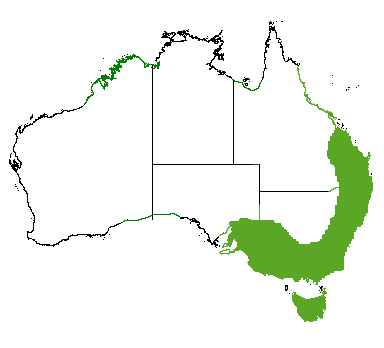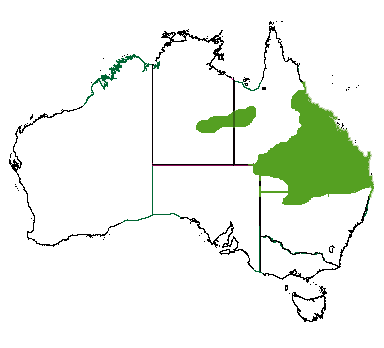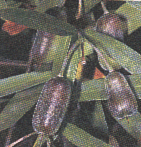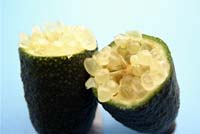This is from the 'Species' section of the Starter Kit:
Fruits - 'A-C'
Austromyrtus dulcis | Billardiera spp | Capparis spp | Citrus australis | Citrus australasica | Citrus glauca
Acronychia acidula

Lemon Aspen

Photo from 'Rainforest Plants' by Nichols
Family
Rutaceae
General notes:
Small (cherry sized) pale lemon coloured fruit with a unique sharp citrus flavour. Found in rainforests from Sydney to the far north. This tangy, yellow, citrus-flavoured fruit comes from a rainforest tree and is as versatile as the lemon.
Edible portion:
Fruit
Harvest period:
Jan-Aug (also quoted as June-July, April- Sept)
Yrs to maturity:
3-4
Form:
Shrub to medium tree (4-8m) Quoted to 18m - likely in rainforest conditions:
Natural Distribution/Growing conditions:
North eastern Queensland. Rainforest, particularly highland. Naturally from Cooktown to Mackay but grown much further south.
Climatic/microclimatic conditions:
Tropical-subtropical. Will tolerate both full sun and semi shade (suggested that full sun increases fruiting.)
Management reference:
Berry fruits. A hardy plant
Traditional Aboriginal Use:
Fruit eaten.
Density:
275/ha
Yield at maturity:
Unknown
Harvesting:
Shake and collect or hand pick. Pole pickers.
Supplied as:
Fresh (local distribution only at this time), as a frozen whole or as a juice.
Typical value adding:
Jams, jellies, sauce, juice. Whole lemon aspen fruits or just the juice can be used in pastries, desserts, sauces and marinades and the pulp from juicing can flavour shortbread or be further infused to extract its unique flavour. The fruit glaces particularly well. Excellent in curds and salad dressings. It is suggested that the leaves can also be used for flavouring.
Current purchasing price:
$6-$10/kg (depending on season and ease of supply)
Perceived demand:
Good - needs work
Research also:
A. oblongifolia (Common achronychia), A. imperforata (Coast aspen), A. wilcoxiana and A. suberosa, A..
From the RIRDC Report
Cultivation of Native Food Plants in Southeastern Australia
A report for the Rural Industries Research and Development Corporation
by Maarten Ryder and Yvonne Latham
January 2005 RIRDC Publication No 04/178
RIRDC Project No CSL-11A
Lemon aspen seems well adapted to surviving, growing and having a generally healthy green appearance in a wide range of environments. Despite the limited fertiliser application, these plants are not showing signs of deficiency. Establishment and early growth have been quite reliable.
Flowers have been observed at several sites, but fruit set has only been seen at one trial. Being a fruit crop, we may need to know more about the pollination mechanisms and requirements of this species to be able to ensure reliable cropping.
The average vigour of lemon aspen has been rated moderate to very good. This plant is the most susceptible to insect attack of all the species in these trials. We have not identified what the particular pest/s is/are but these problems have generally not been of great concern to the overall health and vigour of the plant. Lemon aspen also appears to be affected by a hyperplasia (witches’ broom) which has developed more obvious symptoms at some locations than others.
Links
CSIRO:
http://www.cse.csiro.au/research/nativefoods/crops/aspen.htm
RIRDC Report:
http://www.rirdc.gov.au/reports/NPP/02-109sum.html
Austromyrtus dulcis
|

|
| Midyim Berry |
|
| Family | Myrtaceae |
General Notes:A favorite of the editor's for 'off the bush' eating but this species is not at present considered highly commercial. The pea to cherry sized berry is an attractive grey with interesting purple veining. The taste is sweet and somewhat piney. Slight cinnamon underflavour. New leaves reddish, silky. Fluffy white flowers. A difficult fruit to harvest as the plant is reasonably prostrate and the berries, once ripe, fall off at the slightest movement of the bush. A mesh collar to encourage slightly more upright growth is being trialed.Edible portion:FruitHarvest period:Late Summer - Autumn (they can also fruit twice a year)Yrs to Maturity:1-2Form:Small shrub, 0.3-0.6m H x 1mNatural Distribution/Growing conditions:Largest fruiting plants found on Fraser Island in sand. Also found as an understory in heath and woodlands, Grafton to Fraser. Adequate moisture but above average drainage required.Climatic/microclimatic conditions:Sub tropical to temperate. Favours sunny positions. Can be grown in arid regions with adequate water.Management reference:Berry fruitTraditional Aboriginal Use:The fruits eatenDensity:3000/haYield at maturity:Little documentation. I have seen local bushes with 1kg crops in a good season. Midyim in the more favourable conditions of Stradbroke Island are heavier bearers of a larger fruit.Harvesting:By hand or shake onto ground sheet.Supplied as:Fresh or driedTypical value adding:Dried, as jam or jelly, juice a possibility.Current purchasing price:NCT - estimated $6/kgPerceived demand:Low - market to be developed from scratchResearch also:A. hillii LinksCity Farm: http://www.communitygarden.org.au/ideas/fruits/midyim.html Buy Plants online: http://www.buyplantsonline.com.au/category/1/page/3/item/41 |
|
Billardiera cymosa |
 |
| Sweet apple berry | 
Picture from the Bushfoods and Medicine Forum Gallery |
| Billardiera scandens |  |
|
Apple Berry Indigenous names - Bomula and Karrawang |
Picture: Tim Low |
| Family | Pittosporaceae |
General notes:Non-vigorous twining climber, occasionally shrub-like. Blue, pink or white flowers in spring, followed by reddish berries. A common garden plant in southern Australia. The fruit grows in 1.5cm in clusters, tastes like Kiwi fruit, others like aniseed. Fruits ripen only after they fall to the ground.Edible portion:FruitHarvest period:Summer-AutumnYrs to maturity:2-3Form:Climber if supported, spreading shrub to 3m if not.Natural Distribution/Growing conditions:In eucalypt forest, rainforest and heaths near the coast south of Sydney to Mt Gambier and TAS, also grows in woodland, mallees and coastal heaths in western VIC and SA. Tolerates most soils and aspects. Prefers dry or moist well drained, lighter textured soils in full or filtered sun. Lime tolerant. Very hardy.Climatic/microclimatic conditions:Sub tropical to temperate, frost hardy.Management reference:Chinese Gooseberry. This species needs a host plant or trellis to climb on for best harvesting results. Responds well to light application of slow release fertiliser. May need drip irrigation during dry periods. Requires a moist, well-drained, humus-rich, lime-free soil in sun or semi-shade with a cool root run.PropagationSeed - best sown in a warm greenhouse as soon as it is ripe. Only just cover the seed. Sow stored seed in early spring in a warm greenhouse. The germination of fresh seed is usually prolific, but stored seed can take a year to germinate. When they are large enough to handle, prick the seedlings out into individual pots and grow them on in the greenhouse for at least their first winter. Plant them out into their permanent positions in late spring or early summer, after the last expected frosts. Cuttings of half-ripe wood, 10 - 12cm with a heel, July/August in a frame. Fair percentage. Traditional Aboriginal Use:Aboriginals roasted and ate unripe fruit.Density:UnknownYield at maturity:LowHarvesting:Hand Supplied as:Fresh, frozenTypical value adding:Settlers used it in jams.Current purchasing price:Anecdotally $4-$5/kg sold locally.Perceived demand:Medium - needs promotionResearch also:Billardiera scandens - Apple Berry - variable sized, single fruit, growing in shady eucalypt forests, rainforests and heaths from southern QLD. to Mt Gambier and TAS. B. longiflora (Purple apple-berry), grows in cool moist forests from southern NSW to TAS. B. variifolia (Western bluebell) Sollya heterophylla (Bluebell creeper) grows in south WA. There are more than 20 other Billardiera, some of which are edible.Links:ANBG http://www.cpbr.gov.au/gnp/interns-2002/billardiera-scandens.html ASGAP http://asgap.org.au/b-sca.html Sustainable Gardening Australia: http://www.sgaonline.org.au/plant_billardierascandens.html
|
|
Capparis mitchelli |
 |
| Wild orange |
Picture: Tim Low |
| Family | Capparidaceae |
General notes:This fruit has a seedy pulp with a flavour of orange, mustard and honey. It is best used as a spice rather than being guided by its common name. The bush orange is actually related to capers. White flowers, fruits 5cm. The juvenile is very prickly and this habit may continue into maturity. Some say it tastes like passionfruit with a kerosene aftertaste (actually, it's not that bad!)Edible portion:Fruit and flowers buds. Fruit 20-50mm Harvest period:Spring to late summerYrs to maturity:10Form:Bushy or compact shrub to small tree, 5-8m.Natural Distribution/Growing conditions:Inland temperate regions of Qld, NSW, SA, NT. Isolated regions in Northern WA. Sand or clay loam usually near water courses. Along watercourses and adjacent plains, usually on sand or clay-loam. It is scattered in woodlands throughout the outback. Can be found in dense stands along fencelines in its natural area. Good for dry regions.Climatic/microclimatic conditions:Low rainfall (150-250mm) areas, performs best in arid conditions. Moderately tolerant of drought, frost and lime soil conditions. Management reference:Citrus. A very hardy plant. Slow initial growth unless grafted onto vigorous rootstock. Responds well to pruning. Moderately tolerant of drought, frost and lime soil conditions. Can be pruned and shaped. Gall wasp can parasitise seed but his does not effect flesh.Traditional Aboriginal Use:Fruit eatenDensity:625/haYield at maturity:2kg/plantHarvesting:Hand - a very prickly plant.Supplied as:Fresh, frozenTypical value adding:Jams, jellies, sauces, drinks, glaced,_Current purchasing price:$[5.50-$15.00/kg]Perceived demand: Medium to high.Growing interest in this species as both a rootstock for other citrus and as a grafted variety. Also worth investigating:Capparis lasiantha From the RIRDC Report "Cultivation and sustainable wild harvest of Bushfoods by Aboriginal Communities in Central Australia"Capparis mitchellii (Artwakeye)Extremely slow growing Capparis mitchellii or Bush Orange is common in woodland areas and near or on limestone hills. On Pantharrpilenhe these small trees are mostly found growing in large numbers immediately set back from river banks. They are also found growing on the side of small hills and in protected valleys in much smaller numbers, usually one or two often growing under larger trees such as Acacia estrophiolata (Ironwood) and Corymbia opaca (Bloodwood). These trees appear to need the protective canopy of larger trees against severe frosts and from winds particularly during flowering. The trees found growing on the woodland plains without the protection of larger trees were noticeably smaller and often stunted in appearance. Those trees given protection tended to have better quality fruit. Links RIRDC http://www.rirdc.gov.au/reports/NPP/04-124.pdf (1.3MB) |
|
Citrus australis |
 |
| Round lime |  |
| Family | Rutaceae |
General notes:Small round tropical fruit with a sharp grapefruit, lime flavour. Sourced from several species of native Australian citrus species, these fruits can be found from rainforests to arid areas..Edible portion:FruitHarvest period:Aug-NovYrs to maturity:First fruit at 4-5, maturity at 6-8Form:Tall shrub to 4mNatural Distribution/Growing conditions:Lowland rainforest in sheltered, moist conditions. Found chiefly in SE QLDClimatic/microclimatic conditions:Sun tropical, high rainfallManagement reference:Citrus. However, this species does have some rather nasty spines which make management a little more difficult.Traditional Aboriginal Use:Fruit eatenDensity:Approx 800/haYield at maturity:Variable - 10-20kg treeHarvesting:Hand or semi mechanised as for citrusSupplied as:Fresh, frozen pulp or juiceTypical value adding:With a very strong, tart lime flavour and an edible although slightly bitter yellow/green skin, wild limes make a superb mayonnaise and are well suited to desserts stewed in syrup or honey or traditionally glazed. Try them in sweet or savoury marmaladesCurrent purchasing price:$5-$10/kgPerceived demand: High<h3 "="" style="margin-top: 15px; margin-bottom: 0px; font-family: Verdana, Geneva, Arial, Helvetica, sans-serif; font-size: 11pt; color: rgb(114, 104, 37); text-decoration: overline;">From the RIRDC Report<p "="" style="font-size: 11pt; line-height: 20px; margin-top: 5px; margin-bottom: 0px; margin-left: 5px; font-family: Arial, Helvetica, sans-serif;">"Cultivation of Native Food Plants in Southeastern Australia"<p "="" style="font-size: 11pt; line-height: 20px; margin-top: 5px; margin-bottom: 0px; margin-left: 5px; font-family: Arial, Helvetica, sans-serif;">A report for the Rural Industries Research and Development Corporation <p "="" style="font-size: 11pt; line-height: 20px; margin-top: 5px; margin-bottom: 0px; margin-left: 5px; font-family: Arial, Helvetica, sans-serif;">by Maarten Ryder and Yvonne Latham <p "="" style="font-size: 11pt; line-height: 20px; margin-top: 5px; margin-bottom: 0px; margin-left: 5px; font-family: Arial, Helvetica, sans-serif;">January 2005 <p "="" style="font-size: 11pt; line-height: 20px; margin-top: 5px; margin-bottom: 0px; margin-left: 5px; font-family: Arial, Helvetica, sans-serif;">RIRDC Publication No 04/178 <p "="" style="font-size: 11pt; line-height: 20px; margin-top: 5px; margin-bottom: 0px; margin-left: 5px; font-family: Arial, Helvetica, sans-serif;">RIRDC Project No CSL-11A <p "="" style="font-size: 11pt; line-height: 20px; margin-top: 5px; margin-bottom: 0px; margin-left: 5px; font-family: Arial, Helvetica, sans-serif;">All three Citrus exhibited very good establishment across sites, with the Blood Lime and Desert Lime standing out as the best. The high level of survival across sites is similar to that of Acacia victoriae. The Troyer Citrange rootstock probably plays a large role in the adaptability of the Citrus to different soils and climates. The vigour of Citrus has generally been very good. However many of the plants are reduced in vigour at windy sites (Moonta) and especially a combination of wind and cooler conditions (Kangaroo Is.). Growth in height has been most dramatic at Lyrup and Junee. Future management of the Citrus is likely to involve nutrient management. <h3 "="" style="margin-top: 15px; margin-bottom: 0px; font-family: Verdana, Geneva, Arial, Helvetica, sans-serif; font-size: 11pt; color: rgb(114, 104, 37); text-decoration: overline;">Links:<p "="" style="font-size: 11pt; line-height: 20px; margin-top: 5px; margin-bottom: 0px; margin-left: 5px; font-family: Arial, Helvetica, sans-serif;">Daleys:<p "="" style="font-size: 11pt; line-height: 20px; margin-top: 5px; margin-bottom: 0px; margin-left: 5px; font-family: Arial, Helvetica, sans-serif;">http://www.daleysfruit.com.au/bushfood/roundlime.htm<p "="" style="font-size: 11pt; line-height: 20px; margin-top: 5px; margin-bottom: 0px; margin-left: 5px; font-family: Arial, Helvetica, sans-serif;">New Crops Newsletter:<p "="" style="font-size: 11pt; line-height: 20px; margin-top: 5px; margin-bottom: 0px; margin-left: 5px; font-family: Arial, Helvetica, sans-serif;">http://www.newcrops.uq.edu.au/newslett/ncn10211.htm<p "="" style="font-size: 11pt; line-height: 20px; margin-top: 5px; margin-bottom: 0px; margin-left: 5px; font-family: Arial, Helvetica, sans-serif;">Peter Jones:<p "="" style="font-size: 11pt; line-height: 20px; margin-top: 5px; margin-bottom: 0px; margin-left: 5px; font-family: Arial, Helvetica, sans-serif;">http://members.ozemail.com.au/~peterrjones/bushtucker/limes.htm |
|
Citrus australasica |
 |
| Finger lime |
|
| Family | Rutaceae |
General notes:Closely related to the domestic citrus. A slow growing but hardy species. Interesting and quite delightful long narrow fruits (100mm long) which turn from green to yellow or purple (and other colours!) when ripe.Spacing: 4m x 4m CSIRO have developed hybrids. Orders (which cannot be met) are now coming in from England and Europe (July 2000). A Finger Lime group is in formation - for further information, contact Australian Bushfoods magazine (details in this kit). Edible portion:Fruit - 25 x 100mm. Juice vesicles do not break on opening but pop out like `pearl drops' making this a very attractive garnish.Harvest period:Summer-AutumnYrs to maturity:4-5Form:Evergreen, open, spiny shrub to small tree (3-10m)Natural Distribution/Growing conditions:Rainforest in northern NSW and SE Qld on a wide range of soils. They may be suitable for temperate areas with adequate irrigation and deep, loamy soils.Climatic/microclimatic conditions:Sub-tropical to tropical (more than 1000mm rainfall). Will tolerate light frostManagement reference:Citrus. It has slow growth on its own rootstock but moderate on more vigorous citrus rootstock. it can be grafted onto exotic citrus stock and responds well to pruning. It will grow well in temperate regions with adequate water. Will tolerate moderate frosts and can thus be grown in temperate areas given suitable water. Grafts well onto a range of citrus rootstocks. Will grow in full sun or partial shade. See also NSW DPI Fact Sheet here.Traditional Aboriginal UseFruit eatenDensity:Spacing: 4m x 4m = 625/haYield at maturity:2kg/treeHarvesting:Hand or semi mechanised as for citrusSupplied as:Fresh, frozen, juiceTypical value adding:Jams, jellies, jellies, glace, sauces, drinksCurrent purchasing price:[$8-$15/kg]Perceived demand:High Links:Australian Finger Limes: http://www.fingerlimes.com.au/ ASGAP http://asgap.org.au/c-aust.html Dalyes: http://www.daleysfruit.com.au/plant/Finger-Lime.htm CSIRO http://www.cse.csiro.au/research/nativefoods/crops/citrus.htm List of cultivars: http://www.anbg.gov.au/acra/acra-list-2004.html Nice page on them: http://users.bigpond.net.au/c.mudge/Citrusaustralasica.htm |
|
Citrus glauca(previously Eremocitrus glauca) |
 |
| Wild lime/Desert Lime |
|
| Family | Rutaceae |
General Notes:The greenish/yellow fruits are globular in shape and about 15 mm diameter. The fruits are edible and have a strong citrus flavour, somewhat like West Indian lime. Because of its habitat, Eremocitrus glauca is of interest as a grafting rootstock to possibly extend the range of commercial citrus crops. There is also potential for breeding to develop new citrus varieties.Edible portion:FruitHarvest period:Late spring - summerYrs to maturity:5Form:Medium shrub or small tree generally 3-7 metres in height.Natural Distribution/Growing conditions:Distribution semi arid and arid areas of New South Wales, Queensland and South Australia. In Qld it is often found in Brigalow country or along watercourses inland. It is confined to inland areas, usually on heavy, clay soils.Climatic/microclimatic conditions:Dry inland areasManagement reference:Citrus. The plant has a suckering habit which may need to be controlled in cultivation. Propagation is possible from seed but cuttings may be slow to strike. Grafting or budding onto other citrus stocks has apparently been successful.Density:625/haYield at maturity:2kg/plant Traditional Aboriginal Use Fruits were eatenHarvesting:HandSupplied as:FreshTypical value adding:Sauces and jams, tarts and curd. I have also had a very good result with a glace. Mixes well with ginger. chilli and coriander for butters.Current purchasing price:$[6.50]Perceived demand:Medium to highLinks ASGAP: http://asgap.org.au/e-gla.htmlCSIRO http://www.cse.csiro.au/research/nativefoods/crops/citrus.htmPlantNet http://plantnet.rbgsyd.nsw.gov.au/cgi-bin/NSWfl.pl?page=nswfl&lvl=sp&name=Citrus~glauca |
|


 Go Bushfoods!
Go Bushfoods!







